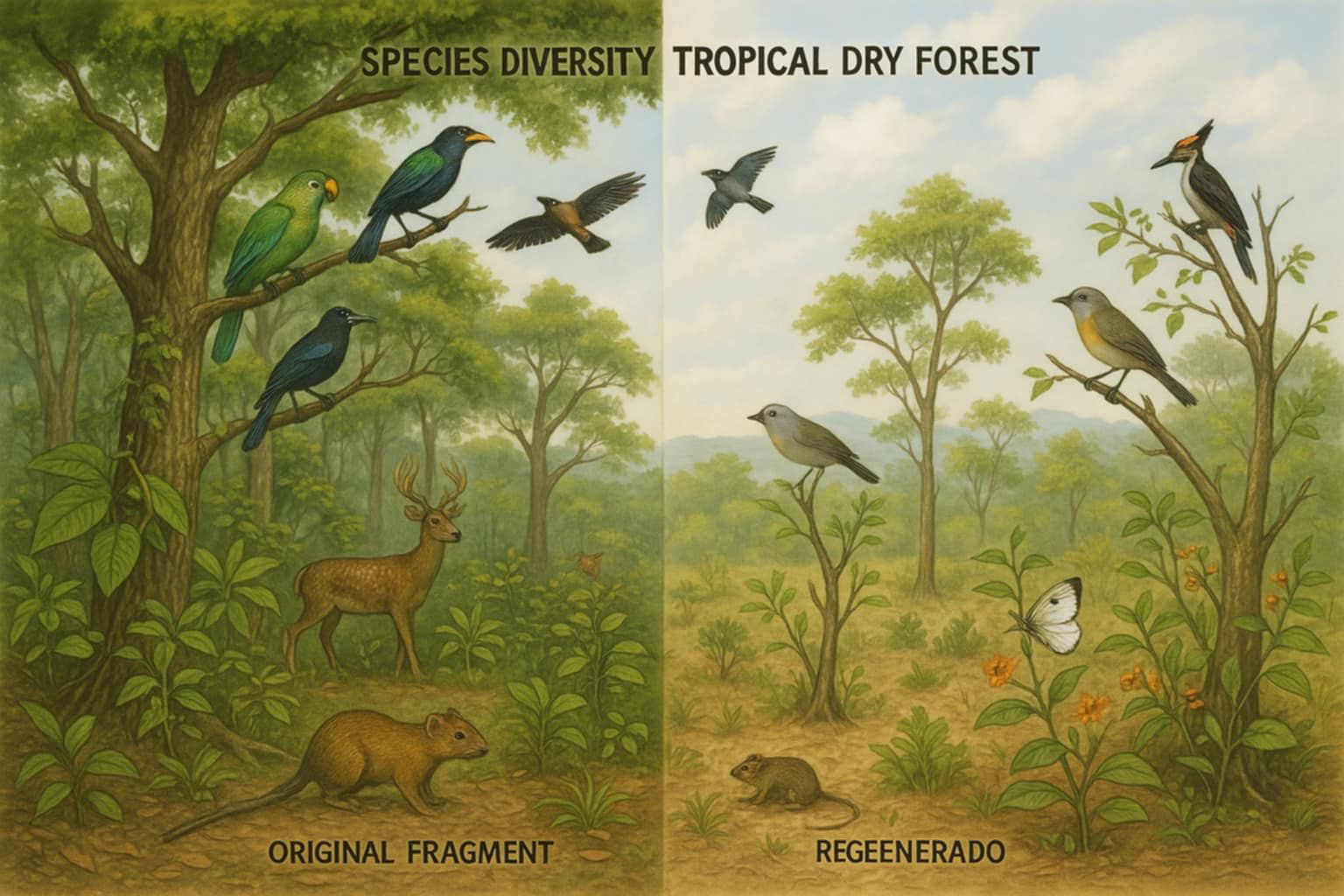Species diversity in tropical dry forests of Ecuador: How effective are regenerated ecosystems
DOI:
https://doi.org/10.56124/sapientiae.v8i17.013Palabras clave:
Bosque seco tropical, Regeneración asistida, Biodiversidad, Sucesión ecológica, Restauración ecológicaResumen
Los bosques secos tropicales son ecosistemas altamente vulnerables a la degradación, cuya restauración requiere estrategias efectivas de conservación. Este estudio evaluó la biodiversidad de un bosque seco tropical en estado natural y un bosque en regeneración asistida, comparando riqueza de especies, equidad y estructura comunitaria. Se establecieron cuatro parcelas de muestreo, de 20 x 50 metros cada una, en ambos ecosistemas y se analizaron índices de diversidad utilizando iNEXT.4steps y el software PAST. Los resultados muestran que el bosque natural presenta una mayor riqueza de especies (54) en comparación con el bosque regenerado (28), así como una distribución más equitativa de las abundancias. La dominancia de especies pioneras en el bosque regenerado indica que aún se encuentra en una etapa temprana de sucesión ecológica. La extrapolación de diversidad sugiere que el ecosistema restaurado difícilmente alcanzará la complejidad del bosque natural en el mediano plazo. Estos hallazgos resaltan la importancia de estrategias de restauración complementarias, como la introducción de especies tardío-sucesionales, para acelerar la convergencia estructural y funcional. El estudio subraya la necesidad de monitoreos a largo plazo para evaluar la efectividad de la regeneración asistida en bosques secos tropicales y sugiere que enfoques de restauración más integrales podrían mejorar la resiliencia y estabilidad de estos ecosistemas.
Descargas
Citas
Arroyo-Rodríguez, V., Melo, F. P. L., Martínez-Ramos, M., Bongers, F., Chazdon, R. L., Meave, J. A., Norden, N., Santos, B. A., Leal, I. R., & Tabarelli, M. (2017). Multiple successional pathways in human-modified tropical landscapes: new insights from forest succession, forest fragmentation and landscape ecology research. Biological Reviews, 92(1). https://doi.org/10.1111/brv.12231
Aryee, G. A., Sardinha, I. D., & Branquinho, C. (2024). Linking drivers of food insecurity and ecosystem services in Africa. In Frontiers in Sustainable Food Systems (Vol. 8). Frontiers Media SA. https://doi.org/10.3389/fsufs.2024.1272332
Blackie, R., Baldauf, C., Gautier, D., Gumbo, D., Kassa, H., Parthasarathy, N., Paumgarten, F., Sola, P., Pulla, S., Waeber, P., & Sunderland, T. (2014). Tropical dry forests. The state of global knowledge and recommendations for future research. CIFOR. https://doi.org/https://doi.org/10.17528/cifor/004408
Cantarello, E., Jacobsen, J. B., Lloret, F., & Lindner, M. (2024). Shaping and enhancing resilient forests for a resilient society. Ambio, 53(8), 1095–1108. https://doi.org/10.1007/s13280-024-02006-7
Chao, A. and Hu, K.-H. (2023). iNEXT.4steps Online: four-steps biodiversity analysis based on iNEXT. Code and user’s guide available from https://chao.shinyapps.io/iNEXT_4steps
Chao, A., & Jost, L. (2012). Coverage-based rarefaction and extrapolation: Standardizing samples by completeness rather than size. Ecology, 93(12). https://doi.org/10.1890/11-1952.1
Chao, A., & Jost, L. (2015). Estimating diversity and entropy profiles via discovery rates of new species. Methods in Ecology and Evolution, 6(8), 873–882. https://doi.org/10.1111/2041-210X.12349
Chao, A., & Ricotta, C. (2019). Quantifying evenness and linking it to diversity, beta diversity, and similarity. Ecology, 100(12). https://doi.org/10.1002/ecy.2852
Chao, A., Gotelli, N. J., Hsieh, T. C., Sander, E. L., Ma, K. H., Colwell, R. K., & Ellison, A. M. (2014). Rarefaction and extrapolation with Hill numbers: A framework for sampling and estimation in species diversity studies. Ecological Monographs, 84(1). https://doi.org/10.1890/13-0133.1
Chao, A., Kubota, Y., Zelený, D., Chiu, C. H., Li, C. F., Kusumoto, B., Yasuhara, M., Thorn, S., Wei, C. L., Costello, M. J., & Colwell, R. K. (2020). Quantifying sample completeness and comparing diversities among assemblages. Ecological Research, 1703.12102 35(2) 292-314. https://doi.org/10.1111/1440
Chazdon, R. (2015). Restoring Tropical Forests: A Practical Guide. Ecological Restoration, 33(1). https://doi.org/10.3368/er.33.1.118
Chazdon, R. L., Brancalion, P. H. S., Lamb, D., Laestadius, L., Calmon, M., & Kumar, C. (2017). A Policy-Driven Knowledge Agenda for Global Forest and Landscape Restoration.Conservation Letters,10(1). https://doi.org/10.1111/conl.12220
Elliott, S.D., D. Blakesley & K. Hardwick, 2013. Restoring Tropical Forests: a Practical Guide. Royal Botanic Gardens, Kew; 344 pp.
Gao, L., Zhao, G., Liang, L., & Chen, B. (2024). Achieving higher eco-efficiency for three staple food crops with ecosystem services based on regional heterogeneity in China. Science of The Total Environment, 948, 174942. https://doi.org/https://doi.org/10.1016/j.scitotenv.2024.174942
Gotelli, N., & Colwell, R. (2011). Estimating species richness. Biological Diversity. Frontiers in Measurement and Assessment, 2. https://doi.org/10.2307/3547060
Hammer, Ø., Harper, D. A. T., & Ryan, P. D. (2001). Past: Paleontological statistics software package for education and data analysis. Palaeontologia Electronica, 4(1).
Holl, K. D., & Aide, T. M. (2011). When and where to actively restore ecosystems? Forest Ecology and Management, 261(10). https://doi.org/10.1016/j.foreco.2010.07.004
Hong, T., & Chongjian, Y. (2024). Research on Ecosystem Service Supply, Demand and Ecological Resilience in the Context of Agriculture-Forestry-Animal Husbandry Composite System in Dibei Zagana, China. Polish Journal of Environmental Studies, 33(2). https://doi.org/10.15244/pjoes/174395
Hortal, J., Borges, P. A. V., & Gaspar, C. (2006). Evaluating the performance of species richness estimators: Sensitivity to sample grain size. In Journal of Animal Ecology, 75(1). https://doi.org/10.1111/j.1365-2656.2006.01048.x
Kumi, S., Nsiah, P. K., AHIABU, H. K., Ofosu-bamfo, B., Asigbaase, M., Anning, A. K., & Amponsah, G. (2024). Forest landscape restoration-induced changes in land cover and woody plant community structure in a degraded forest reserve in Ghana. Trees, Forests and People, https://doi.org/https://doi.org/10.1016/j.tfp.2024.100578 16, 100578.
Letcher, S. G., & Chazdon, R. L. (2009). Rapid recovery of biomass, species richness, and species composition in a forest chronosequence in Northeastern Costa Rica. 7429.2009.00517.x Biotropica, 41(5). https://doi.org/10.1111/j.1744-7429.2009.00517.x
Ma, Y., Wei, J., Wang, W., Huang, C., Feng, C., Xu, D., Haider, F. U., & Li, X. (2024). Monitoring Changes in Composition and Diversity of Forest Vegetation Layers after the Cessation of Management for Renaturalization. Forests, 15(6), 907. https://doi.org/10.3390/f15060907
Mahjoubi, I., Bossenbroek, L., Berger, E., & Frör, O. (2022). Analyzing Stakeholder Perceptions of Water Ecosystem Services to Enhance Resilience in the Middle Drâa Valley, Southern Morocco. Sustainability (Switzerland), 14(8). https://doi.org/10.3390/su14084765
Meli, P., Holl, K. D., Benayas, J. M. R., Jones, H. P., Jones, P. C., Montoya, D., & Mateos, D. M. (2017). A global review of past land use, climate, and active vs. passive restoration effects on forest recovery. In PLoS ONE (Vol. 12, Issue 2). https://doi.org/10.1371/journal.pone.0171368
Mesa-Sierra, N., de la Peña-Domene, M., Campo, J., & Giardina, C. P. (2024). Restoration of tropical dry forest: an analysis of constraints and successes across a highly threatened biome. In Frontiers in Environmental Science (Vol. 12). Frontiers Media SA. https://doi.org/10.3389/fenvs.2024.1458613
Miles, L., Newton, A. C., DeFries, R. S., Ravilious, C., May, I., Blyth, S., Kapos, V., & Gordon, J. E. (2006). A global overview of the conservation status of tropical dry forests. Journal of Biogeography, 33(3). https://doi.org/10.1111/j.1365-2699.2005.01424.x
Murphy, P. G., & Lugo, A. E. (1986). Ecology of tropical dry forest. Annual Review of Ecology and Systematics. 17. https://doi.org/10.1146/annurev.es.17.110186.000435
Oliveira, P. S., Falcão, L. A. D., Almeida, J. S., Fernandes, G. W., Reis Júnior, R., Nunes, Y. R. F., Veloso, M. das D. M., Beirão, M. do V., Neves, F. de S., Solar, R. R. C., Borges, M. A. Z., Silva, A. C., Salomão, R. P., Iannuzzi, L., Silva, L. F., Cabral, G. A. L., Sampaio, E. V. S. B., Macedo-Reis, L. E., Santos, C. F., … do Espírito Santo, M. M. (2024). Diversity patterns along ecological succession in tropical dry forests: a multi-taxonomic approach. Oikos, 2024(4), e09653. https://doi.org/https://doi.org/10.1111/oik.09653
Oluwajuwon, T. V., Chazdon, R. L., Ota, L., Gregorio, N., & Herbohn, J. (2024). Bibliometric and literature synthesis on assisted natural regeneration: an evidence base for forest and landscape restoration in the tropics. Frontiers in Forests and Global Change, 7, 1412075. https://doi.org/10.3389/ffgc.2024.1412075
Pielou EC. 1966. The measurement of diversity in different types of biological collections. Journal of Theoretical Biology 13(C). https://doi.org/10.1016/0022-5193(66)90013-0
Poorter, L., Bongers, F., Aide, T. M., Almeyda Zambrano, A. M., Balvanera, P., Becknell, J. M., Boukili, V., Brancalion, P. H. S., Broadbent, E. N., Chazdon, R. L., Craven, D., de Almeida-Cortez, J. S., Cabral, G. A. L., de Jong, B. H. J., Denslow, J. S., Dent, D. H., DeWalt, S. J., Dupuy, J. M., Durán, S. M., … Rozendaal, D. M. A. (2016). Biomass resilience of Neotropical secondary forests. Nature, 530(7589). https://doi.org/10.1038/nature16512
Rath, S., Kiran Kumara, T. M., Das, A., & Sarangi, K. K. (2024). Economic Valuation of Ecosystem Services in Indian Agricultural Landscape: A Meta-analysis. Economic Affairs (New Delhi), 69(2), 939–950. https://doi.org/10.46852/0424-2513.3.2024.19
Reid, J. L., Holl, K. D., & Zahawi, R. A. (2015). Seed dispersal limitations shift over time in tropical forest restoration. Ecological Applications, 25(4). https://doi.org/10.1890/14-1399.1
Shannon CE. 1948. A Mathematical Theory of Communication. Bell System Technical Journal 7305.1948.tb01338.x 27(3). https://doi.org/10.1002/j.1538-7305.1948.tb01338.x
Simpson EH. 1949. Measurement of diversity. Nature 163(4148). https://doi.org/10.1038/163688a0

Publicado
Versiones
- 2025-07-10 (5)
- 2025-07-10 (4)
Cómo citar
Número
Sección
Licencia
Derechos de autor 2025 Revista Científica Multidisciplinaria SAPIENTIAE. ISSN: 2600-6030

Esta obra está bajo una licencia internacional Creative Commons Atribución-NoComercial-CompartirIgual 4.0.

2.jpg)

















